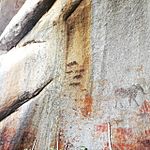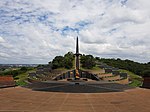National Monuments of Zimbabwe
The National Monuments of Zimbabwe are protected and promoted in accordance with the National Museums and Monuments Act 1972.National Museums and Monuments of Zimbabwe (NMMZ) is the body responsible for maintaining the Archaeological Survey, the national inventory of monuments and sites.[4] In April 2000 there were approximately 14,000 entries on the Archaeological Survey, of which 118 were National Monuments (including natural, cultural, and mixed sites).[4] 79 National Monuments had been declared under the old system by 1954.[3] By 1980, the register had grown to over 3,000 sites and 169 declared monuments.[3]
National Monuments
The National Monuments register includes the following sites:[3]
| Site | Location | Date | Comments | Coordinates | Image |
|---|---|---|---|---|---|
| Great Zimbabwe | Masvingo | 11-15th centuries | UNESCO World Heritage Site |
20°16′23″S 30°56′04″E / 20.273063°S 30.934344°E | 
|
| Khami | Bulawayo | 15-17th centuries | UNESCO World Heritage Site |
20°09′30″S 28°22′36″E / 20.15833°S 28.37667°E | 
|
| Domboshawa Cave | Domboshawa |
Ancient rock art | 17°36′S 31°08′E / 17.600°S 31.133°E | 
| |
| Ziwa | Nyanga | 17-18th centuries | UNESCO Tentative List |
18°08′S 32°38′E / 18.133°S 32.633°E | 
|
| National Heroes Acre | Harare | 1981 | 
| ||
| Mashonaland West Provincial Heroes Acre | Mashonaland West |
Site of the Battle of Sinoia | 17°21′25″S 30°16′26″E / 17.357°S 30.274°E | ||
Matobo Rock Art Sites |
Matobo National Park | UNESCO World Heritage Site |
20°33′00″S 28°30′29″E / 20.55000°S 28.50806°E | 
| |
| Tsindi | |||||
| Harleigh Farm | |||||
| Diana's Vow | |||||
| Chamavara | |||||
| Zinjanja | |||||
| Majiri | |||||
| Alter site | |||||
| Kagumbudzi | |||||
| Matendera | |||||
| Jumbo Mine | |||||
| Dambarare | |||||
| Fort Makaha | |||||
| Tohwechipi's Grave | |||||
| Statue of Mbuya Nehanda | Harare | 25 May 2021 | Monument |
See also
References
- ICCROM. pp. 5, 18–21. Retrieved 8 May 2012.
- ^ "National Museums and Monuments Act". www.law.co.zw. Retrieved 8 May 2012.
- ^ ICCROM. pp. 42–45. Retrieved 8 May 2012.
- ^ a b "Zimbabwe" (PDF). UNESCO. Retrieved 8 May 2012.
